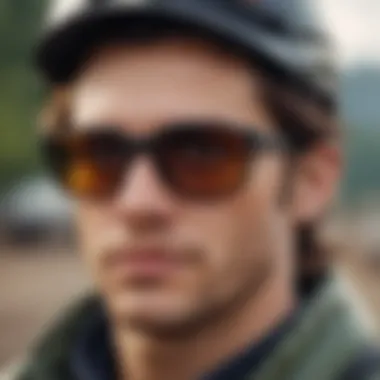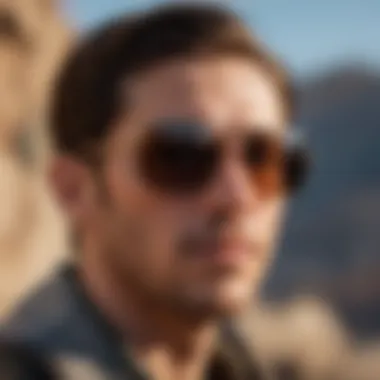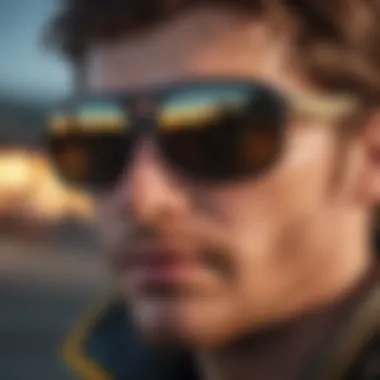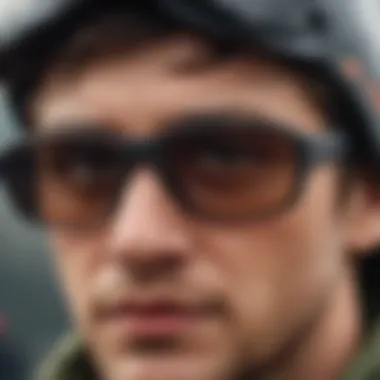The Evolution and Impact of 90s Sunglasses in Extreme Sports Culture


Intro
The 1990s marked a significant era in extreme sports culture, profoundly influencing not just the activities themselves, but also the aesthetics surrounding them. Sunglasses from this decade became more than mere accessories; they emerged as essential gear. Their design and functionality catered to the needs of athletes who sought both style and performance while pushing the limits of their physical abilities.
In this article, we will explore the changing role of 90s sunglasses within extreme sports. We aim to uncover how they merged fashion and utility, as well as their resonance with the culture of adventure and excitement. Understanding these sunglasses' aesthetic appeal, practical advantages, and cultural significance allows enthusiasts to appreciate what lies behind their multifaceted influence.
Extreme Sports Overview
Definition of Extreme Sports
Extreme sports are characterized by their high risk, intense physicality, and the need for specialized gear. These activities often push human limitations and sometimes function just outside conventional sports frameworks. Participants engage for the thrill and adrenaline rush generated by challenges faced in environments that demand skill and courage.
History and Evolution
The roots of extreme sports trace back to the 1960s and 70s with activities like skateboarding and surfing gaining popularity. However, by the 1990s, the term "extreme sports" became mainstream as snowboarding, BMX, and rock climbing entered public consciousness.
Sunglasses played a pivotal part in the evolution of these sports. As athletes began to push boundaries, the eyewear needed to reflect that ethos while catering to safety and function. Innovative designs led to enhanced lens technology and frames durable in tough conditions.
Popular Extreme Sports Disciplines
Several disciplines became especially prominent in the 90s, reshaping the extreme sports landscape:
- Skateboarding: Gained increased visibility through competitions and media.
- Snowboarding: Experienced a surge as technology advanced and resorts embraced the sport.
- BMX Racing: Became a staple in youth culture, featured prominently in competitions and exhibitions.
- Rock Climbing: Expanded in scope, both sport and outdoor climbing flourished.
These disciplines contributed to a broader acceptance and recognition of extreme sports, with sunglasses becoming crucial to not only enhance performance but also to craft identity within these communities.
"90s sunglasses reflected a unique blend of fashion and functionality, tailoring aesthetics to the extreme sports realm while ensuring comfort and protection for athletes."
Gear and Equipment
Essential Gear for Different Sports
Every extreme sport comes with its unique set of necessities. In the case of skiing and snowboarding, for instance, protective eyewear is just as vital as a secure helmet. In many situations, 90s sunglasses offered critical features like UV protection and anti-fog technology.
Gear Reviews and Comparisons
Many brands dominated the eyewear market during this decade. Names like Oakley and Ray-Ban became synonymous with quality and style. Their products frequently merged performance with aesthetic value, appealing to both serious athletes and casual wearers.
Comparative reviews emphasize features such as:
- Lens tint variations: Offering different visibility levels under various conditions.
- Frame durability: Resilience against physical impacts and environmental variables.
- Fit and comfort: Ensuring the eyewear stayed in place regardless of vigorous activity.
Safety Ratings and Certifications
The importance of safety ratings is paramount, especially with eyewear worn during high-risk activities. The American National Standards Institute (ANSI) provides guidelines to help consumers choose appropriate gear. Sunglasses earning these certifications are typically designed to withstand impacts more effectively, ensuring athletes' eyes remain protected.
Training and Preparation
Physical Conditioning and Fitness Tips
Performance in extreme sports relies heavily on physical strength, endurance, and agility. Training regimens varies greatly between sports. However, overall fitness remains key to succeeding in even the most niche areas. Incorporating cross-training can be beneficial, focusing on cardiovascular health and muscle conditioning necessary for demanding activities.
Mental Preparation Techniques
Extreme sports can be mentally taxing. Many athletes rely on visualization techniques to prepare for challenges they may face. Mindfulness practices can enhance focus and reduce anxiety, aiding in the performance of athletes seeking to push boundaries.
Training Regimens for Various Sports
Different extreme sports often require tailored training. For skiers, agility drills may be crucial, while rock climbers might focus on grip strength and endurance. Setting clear goals and implementing specific training schedules helps athletes prepare effectively.
Locations and Destinations


Top Destinations for Extreme Sports
Identifying key locations can enhance the experience of extreme sports participants. Places like Whistler, British Columbia, and Moab, Utah offer prime environments for skiing, mountain biking, and climbing.
Travel Tips and Guides
When planning an extreme sports trip, consider local regulations, seasonal variations, and safety protocols. To maximize experiences, familiarize yourself with available gear rentals and local guides. These professionals can provide insights that enhance overall participation, ensuring safety and enjoyment.
Prelims to 90s Sunglasses
The 1990s were a pivotal decade for fashion, setting the stage for numerous trends that would echo through generations. Among these trends, sunglasses emerged not just as a utilitarian accessory but as an essential element of identity in extreme sports culture. Understanding the evolution of 90s sunglasses involves delving into the confluence of style, function, and culture.
Cultural Context of the 90s
The cultural landscape of the 1990s was vibrant and dynamic. This was the era of grunge, hip-hop, and the dawn of the internet. Young people sought to express their individuality, often using fashion as a primary medium. Extreme sports, such as snowboarding, skateboarding, and BMX, gained immense popularity during this time.
Sunglasses became more than a protective item; they were a symbol of rebellion and a statement of lifestyle. Athletes and enthusiasts alike adopted styles that marked them as part of a rebellious subculture. This decade also resonated with the rise of youth identity, where accessories played a crucial role in defining one’s persona. As such, the glasses worn by extreme sports athletes became iconic within this context.
Initial Popularity of Sunglasses
The initial appeal of sunglasses in the 90s can be linked to various factors. First, advancements in lens technology made eyewear not only fashionable but also functional. Shaded lenses, UV protection, and polarized options came into the fray, catering to both style-conscious consumers and serious athletes.
Moreover, brands like Oakley, Ray-Ban, and Smith Optics seized the moment. They introduced designs that appealed to the athletically inclined while pushing the boundaries of aesthetics. These brands skillfully marketed their sunglasses through collaborations with extreme sports athletes, effectively marrying performance and fashion.
"Sunglasses from the 90s symbolize not just protection against the sun, but also the evolution of sports gear into style statements."
As these shades gained popularity, they also played a role in defining events, lifestyles, and communities. Competitions showcased not just athletic prowess but also showcased the sunglasses as must-have gear. Understanding this origin is crucial as it reveals how foundational the 90s were in shaping modern performance eyewear in extreme sports.
Design Aesthetics of 90s Sunglasses
The design aesthetics of 90s sunglasses are significant as they reflect not only the fashion trends of the decade but also the functional needs of extreme sports enthusiasts. This era showcased a diverse range of styles that catered to both aesthetic and practical concerns. The balance between functionality and design played a crucial role in making these sunglasses a staple among athletes and adventure seekers alike.
Key Design Trends
In the 1990s, sunglasses underwent a transformation that mirrored the cultural shifts during that time. The rise of extreme sports invigorated new designs that combined bold silhouettes with dynamic angles. Large, oversized frames became popular, drawing attention and offering a unique statement. Aviators and wrap-around styles were emblematic of this era, providing both coverage and a sporty look. The combination of varied shapes—ranging from geometric to rounded—allowed enthusiasts to express individuality while ensuring maximum protection against sun glare.
The trend of customizing sunglasses became common, making options for interchangeable lenses and colored frames. Markedly, the adoption of tinted lenses revealed a playful side to functionality, with options ranging from reflective to gradient styles.
Material Innovations
Material advancements also played a pivotal role in the sunglasses of the 90s. Lightweight polymers became the norm, making sunglasses more comfortable for prolonged wear during extreme activities. These materials offered durability without compromising style. Polycarbonate lenses gained traction as they not only provided superior impact resistance but also reduced weight significantly.
Flexible frames were developed to meet the robust demands of extreme sports. Athletes needed sunglasses that adapted to their vigorous movements, and innovations such as rubberized temples were introduced to prevent slippage. This attention to material science ensured that the sunglasses could withstand harsh outdoor conditions—rain, sun, or wind.
Iconic Colors and Patterns
Colors and patterns distinguished the sunglasses of the 90s, defining a generation. Bright neons, bold primary colors, and eye-catching patterns were prevalent in designs. These choices were not merely for aesthetics; they represented the spirit of adventure and rebellion associated with extreme sports culture.
Brands began to explore unique graphics and logo placements, further enhancing the brand's identity. From military-inspired camo frames to funky, vibrant designs, the visual culture of the 90s sunglasses was varied and expressive.
"The design elements were not just trends; they were a part of the experience, echoing the thrill of the sports they represented."
The influence of 90s sunglasses continues to be felt today, as the design principles from that time serve as inspiration for contemporary eyewear in extreme sports. By merging innovation with daring aesthetics, the 90s laid the foundation for how performance gear is perceived in the context of fashion.
The Role of Branding and Marketing
The role of branding and marketing in the evolution of 90s sunglasses within the extreme sports culture cannot be overstated. Brands did not merely sell products; they crafted identities that resonated with a generation seeking adventure and self-expression. This interplay between branding and consumer perception shaped not only the market for sunglasses but also defined the larger aesthetic surrounding extreme sports.
The competitive landscape of the 90s saw brands like Oakley, Ray-Ban, and Smith harness the power of strategic branding. They understood that for extreme sports enthusiasts, sunglasses represented more than just eye protection. These products signaled belonging to a community, a lifestyle. Thus, the importance of branding transformed sunglasses into icons, making them essential for both safety and style.
Key Brands of the 90s


The 1990s witnessed powerful brands that set the standard for sunglasses designed for extreme sports. Oakley emerged as a leader with their innovative designs and bold marketing strategies. Their sunglasses were not only functional for performance but also aligned with the avant-garde mentality of adrenaline junkies.
Ray-Ban, with its timeless aviators and Wayfarers, maintained its status through a blend of classic appeal and modern endorsements. Smith, catering to snow sports enthusiasts, incorporated technology that ensured visual clarity and frame durability. These brands utilized their identities to create aspirational products, which in turn led to increased brand loyalty among consumers.
Celebrity Endorsements and Influence
Celebrity endorsements played a crucial role in amplifying the visibility of these brands. Athletes such as BMX rider Mat Hoffman and skateboarding legend Tony Hawk became the face of these products. Their influence extended beyond their sports; they represented a culture fueled by ambition and daring. This connection between celebrities and sunglasses made them more than mere accessories. They became symbols of achievement and style.
The strategic partnerships did not end with athletes alone. Movies that showcased extreme sports often highlighted characters wearing iconic sunglasses. This exposure contributed to a perception of coolness around specific brands, enticing consumers to adopt similar styles in their everyday lives. When a celebrity or sports figure wore a particular brand, it triggered a desire for those sunglasses among fans.
Advertising Campaigns That Shaped Trends
The advertising campaigns of the 90s spotlighted extreme sports in a way never seen before. They were not just selling sunglasses; they were selling a lifestyle characterized by thrill and freedom. Campaigns often featured real athletes pushing their limits while wearing brand products. These visuals created a direct association between sunglasses and high-performance activity, solidifying their necessity in the minds of consumers.
Promotional strategies included extreme sports events, where brands showcased their latest styles. The use of bold visuals and compelling narratives captured the essence of the extreme sports world. This not only strengthened brand recognition but also fueled trends that resonated deeply with the subculture.
As the decade progressed, the saturation of advertising led to a colorful marketplace. Brands had to innovate and differentiate to stand out. They began to embrace distinct styles, ensuring that each was uniquely positioned within the market. This strategy not only benefited the brands but also provided consumers with a plethora of choices, allowing them to express their individuality through eyewear.
"Branding in the 90s was a fusion of community and commerce, igniting a passion for eyewear that defined the era."
In summary, branding and marketing shaped the narrative surrounding 90s sunglasses in extreme sports. Brands crafted identities that resonated with consumers, celebrity endorsements amplified their reach, and innovative advertising campaigns created a marketplace rich with options. This cocktail of factors solidified sunglasses' status as a must-have accessory for those living life on the edge.
Functionality Versus Fashion
Understanding the interplay between functionality and fashion in sunglasses is essential in the context of extreme sports. In the 1990s, athletes and enthusiasts did not merely seek a stylish accessory; they required eyewear that could withstand the challenges posed by their activities. The choice of sunglasses went beyond aesthetics; it involved critical features that affected performance and safety.
Protective Features in Extreme Sports
The primary function of sunglasses in extreme sports centers around protection. High levels of UV radiation, impacts from debris, and extreme weather conditions are commonplace in activities like skiing, mountain biking, or surfing.
Key protective features include:
- UV Protection: A vital characteristic, as excessive exposure to ultraviolet rays can cause long-term eye damage. Quality eyewear from the 90s typically featured lenses capable of blocking 99% to 100% of UV light.
- Impact Resistance: Polycarbonate lenses became popular because they are lightweight and highly resistant to impact. They are crucial for athletes in fast-paced environments.
- Anti-Fog and Anti-Scratch Coatings: These coatings enhanced visibility while ensuring durability, significant for athletes wearing sunglasses during physical exertion or in unpredictable climates.
Modern extreme sports sunglasses take these protective features even further, but many foundational aspects can be traced back to innovations from the 90s.
Adoption by Athletes and Adventurers
The adoption of these sunglasses by professional athletes and adventurers profoundly influenced their popularity. Icons like Tony Hawk in skateboarding or Kelly Slater in surfing showcased sunglasses not only as protective gear but also as a statement of identity and style.
Athletes often became brand ambassadors, promoting the benefits of certain designs. This connection helped establish various brands as leaders in both function and fashion. Enthusiasts sought the same gear used by professionals, leading to higher sales and more diverse designs available in the market.
Evolution of Performance Eyewear
Over the decade, performance eyewear evolved significantly. Initial designs focused primarily on aesthetics, but as the extreme sports culture grew, the demand for functional improvements surged. Sport-specific models began emerging, tailored for specific activities.
For instance, specialized lenses for mountain biking provided enhanced contrast in various terrains, while polarized lenses were favored for water sports to reduce glare. Brands like Oakley and Ray-Ban started incorporating advanced materials and technology into their designs, catering to an increasingly discerning clientele.
"The 90s marked a shift in the perception of sunglasses from mere fashion items to essential equipment for sports performance."
By blending style with performance, the market established a robust framework that shaped the future of sports eyewear. Today's designs continue to reflect the evolution witnessed during this dynamic decade, where the balance of functionality and fashion laid the groundwork for the modern extreme sports enthusiast.
Cultural Significance in Extreme Sports
90s sunglasses significantly influenced the culture of extreme sports. They were not just practical eyewear; they symbolized identity, status, and affiliation within various extreme sports communities. During this decade, participation in activities like skateboarding, snowboarding, and rock climbing surged. Sunglasses became essential gear that complemented the aesthetics of these sports, while also enhancing functionality and protection.
The sunglasses of this time often featured bold designs and vibrant colors that resonated with the youth of the era. Athletes sought products that showcased their personalities and lifestyles. These sunglasses were not only worn for sun protection; they also communicated a rebellious spirit, a willingness to take risks, and an embrace of thrilling experiences. The blend of fashion and utility was crucial, as athletes needed reliable gear that stood up to the demands of their extreme activities while still looking stylish.
Moreover, as extreme sports grew in popularity, so did the cultural significance of the associated fashion. Sunglasses transcended mere function; they became icons of lifestyle and culture. They were frequently seen in media depictions of sports, further embedding them within the cultural narrative. This shift contributed to a sense of community and belonging among extreme sports enthusiasts.
"Sunglasses were a badge of honor in extreme sports culture, defining who you are as much as your skills did."


90s Sunglasses in Popular Extreme Sports
In the 1990s, different extreme sports adopted specific styles of sunglasses that mirrored their unique cultures and environments. For skateboarders, brands like Oakley became a staple. Their wrap-around lenses provided necessary protection during tricks and falls. Similarly, snowboarders gravitated toward brands that fused style with performance, with products designed to withstand harsh conditions while offering eye protection.
When it comes to rock climbing, sunglasses were essential not only for sun protection but also for safety against debris. Lightweight materials were favored in this community. Additionally, the variety of colors and shapes showcased individuality among climbers, who often emphasized their personal styles as much as their gear's performance.
This trend created a roadmap for current eyewear branding, reflecting how deeply 90s sunglasses were integrated into various sports' aesthetics, from casual wear to high-performance equipment.
Connection with Subcultures
The connection between 90s sunglasses and various subcultures cannot be overstated. The eyewear represented more than just trend; it reflected values of freedom and individuality. Subcultures like punk and alternative embraced the bold styles of the eyewear, making it part of their statement against the mainstream. The designs often broke away from traditional norms, featuring eccentric shapes and bright colors.
Fashion choices like oversized frames or tinted lenses signified a rejection of societal standards. Extreme sports were inherently tied to these ideals of rebellion and self-expression. Thus, the sunglasses that adorned athletes and enthusiasts alike became symbols of a broader cultural movement, steeped in the ethos of personal freedom and defiance against expectations.
Communities united over shared passions led to a vibrant exchange of ideas and styles, marking the 90s as a pivotal decade for both extreme sports and fashion. Overall, the interplay between 90s sunglasses and subcultures underscored their importance beyond aesthetic appeal, highlighting their role in shaping identities.
Nostalgia and Revival of 90s Styles
The fascination with 90s sunglasses has grown remarkably in recent years, establishing a connection between past trends and modern preferences. Nostalgia plays a significant role in this revival. The 1990s represented a unique blend of cultural movements, characterized by vibrant aesthetics and a distinct rebellious spirit that resonates with today's extreme sports culture.
This resurgence is not merely about looking back; it combines a love for vintage styles with contemporary functionality. Extreme sports enthusiasts find value in eyewear that not only reflects a bygone era but also aligns with their active lifestyle. With 90s sunglasses, there is a recognition of both their stylish design and protective capabilities, making them suitable for a variety of activities.
The revival brings several benefits for consumers. These sunglasses evoke a sense of identity among wearers, linking them to the adventurous spirit of the 90s. Additionally, brands that were iconic during this time have reissued popular models with modern technology, enhancing comfort and performance while maintaining the aesthetic appeal of their originals.
Here are some specific elements that make this trend impactful:
- Cultural Memory: Many enthusiasts remember the 90s fondly, making these sunglasses more than just an accessory; they are a piece of nostalgia.
- Style Versatility: The various designs can suit multiple fashion senses, appealing to both retro lovers and new adopters alike.
- Brand Loyalty: Re-emerging brands leverage their history to connect with consumers, establishing a sense of trust and quality.
Overall, the nostalgia surrounding 90s sunglasses serves as a bridge between past and present, enhancing their significance in extreme sports culture.
Current Trends Inspired by the 90s
Current fashion trends have undeniably caught the essence of 90s sunglasses. Designs that were once popular are being adapted into modern fashions, sometimes with a twist, while still reflecting the boldness of that decade.
Popular styles include oversized frames, vibrant colors, and angular shapes. Brands like Oakley and Ray-Ban have seized the moment, reintroducing classic styles to cater to the current market. Furthermore, limited edition releases create a sense of urgency and excitement for fans and collectors alike.
Another relevant trend is sustainability. Many consumers today prefer eco-friendly products. Consequently, brands are increasingly creating sunglasses using recycled or sustainable materials, blending the aesthetics of the 90s with modern environmental consciousness.
Influence on Modern Extreme Sports Fashion
The impact of 90s sunglasses on contemporary extreme sports fashion goes beyond mere aesthetics; they enhance performance while expressing individual style. As athletes and thrill-seekers engage in high-octane activities, the right eyewear does both — it protects the eyes from UV rays and debris while complementing their gear.
The bold characteristics of the 90s styles have found their way into modern sports fashion, influencing designs and marketing strategies within the industry. Recognizable shapes and colors embody a rebellious attitude, appealing to a younger demographic and established athletes alike.
In addition, social media platforms have amplified this trend. Influencers and athletes showcase their styles, further propagating the revival of 90s aesthetics within extreme sports. As these figures promote their favorite brands, the choices they make amplify the cultural significance of 90s sunglasses in today’s sports realm.
Ultimately, the revival of 90s sunglasses plays a crucial role in shaping the identity of those involved in extreme sports, balancing style, functionality, and a connection to an exhilarating history.
Finale
The examination of 90s sunglasses highlights their profound importance within the extreme sports culture. Sunglasses from this decade did not merely serve an aesthetic purpose; they became essential tools for performance, protection, and identity. The intersection of style and functionality remains a key element of their ongoing legacy.
Summary of Insights Gained
Throughout this article, we explored multiple facets of 90s sunglasses. The cultural context of the 1990s set the stage for their rise, reflecting a period characterized by bold designs and material innovation. Key brands emerged, utilizing aggressive marketing strategies and celebrity endorsements which elevated sunglasses to symbols of not only fashion but also lifestyle.
The exploration of functionality versus fashion emphasized the necessity for protective features in extreme conditions. Athletes adopted sunglasses that combined utility with distinctive designs, influencing a generation of thrill-seekers
The cultural significance in extreme sports could not be overlooked. These sunglasses played a pivotal role in shaping the aesthetics and functionality that define modern extreme sports, demonstrating how accessories can embody a sense of community and adventure.
Future Outlook for Sunglasses in Sports
As we look forward, it is clear that the legacy of 90s sunglasses continues to influence both style and technology in sports eyewear. Many brands are revisiting the aesthetics of this era, integrating vintage design elements with contemporary performance technology.
Anticipating future trends, we may see a further blending of smart technology in eyewear. Advancements like augmented reality and enhanced lens technologies could redefine what sports eyewear means.
Moreover, the increasing emphasis on individual expression in sports fashion points towards a continued fusion of personal style and high-performance capabilities.
The enduring appeal of 90s sunglasses remains undiminished, and as new generations of athletes and enthusiasts emerge, the essence of that iconic decade in eyewear will likely persist.







